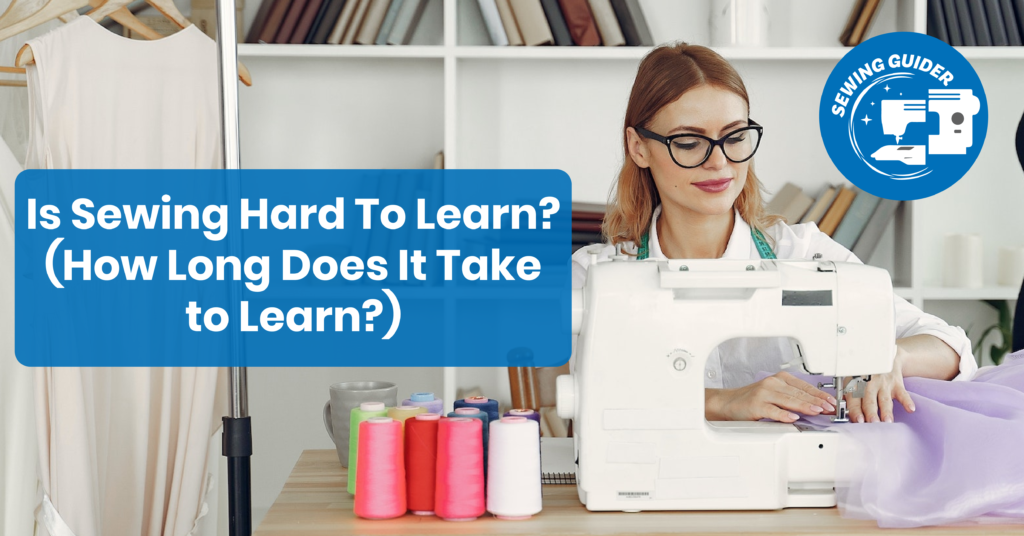Sewing has been a popular pastime and skill for many generations, and is seeing a resurgence in popularity in recent years. Whether you are interested in making your own clothing or household items, or want to learn a new skill, sewing is a great option. However, the question of whether or not sewing is difficult often comes up for those who are considering starting to learn. In this article, we will explore the topic of sewing and answer whether it is hard to learn and how long it takes to become proficient.
Definition
Sewing is the process of joining fabrics together using a needle and thread. It is an ancient art form that has been used for thousands of years to create a wide range of items, from clothing to household textiles and accessories. Sewing can be done by hand or with a machine, and there are many different techniques and styles to choose from, depending on your interests and goals.
Understanding The Difficulty Of Sewing
Sewing can be challenging for some people, but it is not necessarily hard for everyone. The difficulty of sewing depends on several factors, including your experience level, the type of project you are working on, and the quality of your tools and equipment.
For those who have no prior experience with sewing, it can be a little intimidating at first. However, with practice and patience, anyone can learn to sew. The learning process can be slow at first, but as you become more comfortable with the basics, you will find that it gets easier and more enjoyable.
One of the factors that can affect the difficulty of sewing is the type of project you are working on. Some projects, such as simple repairs or small accessories, may be easier to complete than others, like making your own clothing or upholstering a piece of furniture. Choosing projects that are appropriate for your skill level and working your way up as you gain more experience and confidence is important. Another factor to consider is the quality of your tools and equipment. Good quality tools and equipment will make sewing easier and more enjoyable. For example, a good quality sewing machine will be easier to use and less likely to cause frustration and disappointment than a cheap machine that breaks down frequently.
Misconceptions About Sewing
There are also common misconceptions about sewing that can make it seem harder than it is. For example, many people believe that sewing is only for women or that it is only for those with a certain level of skill or talent. These misconceptions can be discouraging, but the truth is that anyone can learn to sew, regardless of gender, age, or skill level.
What Should I Learn First When Sewing?

If you decide that you want to learn how to sew, then you will want to know where exactly you should concentrate your efforts. There are so many different things that you may want to learn about sewing that it can be overwhelming for even the most seasoned of seamstresses. To help make your decision easier when deciding what types of projects are the best ones for you to take on, take some time and read over this article.
There are many different things that you should learn about sewing before anything else in your sewing career. You will want to buy a sewing machine, and learn how to use it. You will then want to learn how to thread the machine properly and then how the various parts of it work. These skills can make all the difference when it comes time for you to be able to sew really intricate projects. Learning how to use a sewing machine is probably one of the most important things you will ever do as a sewer.
There is a big range of skills that you may need to learn before you begin stitching up your first project. You will want to learn how to cut out your pattern pieces and then how to use these pieces as a guide when sewing something.
How Long Does It Take To Learn Sewing?
The length of time it takes to learn sewing can vary greatly, depending on several factors. For example, if you are dedicating a lot of time and effort to practicing and learning, you may be able to pick up the basics of sewing more quickly than someone who is only able to dedicate a few hours a week. The method of learning is also a factor. If you are self-taught, it may take longer than if you are taking classes or receiving one-on-one instruction. Finally, natural ability also plays a role. Some people may pick up sewing more quickly than others, just as with any other skill.
However, in general, it is possible to learn the basics of sewing in a few weeks or months with consistent practice. As with any skill, the more you practice, the better you will become. It is important to be patient with yourself and to focus on the progress you are making, rather than comparing yourself to others.
Tips For Making The Learning Process Easier
Having a clear goal in mind can help make the learning process easier and more enjoyable. Whether you want to make your own clothing, create home décor items, or learn a new skill, having a specific goal can help keep you motivated and focused. Starting with simple projects can also help build confidence and prevent frustration. As you become more comfortable with the basics, you can gradually work your way up to more complex projects.
Finding helpful resources can also make the learning process easier. Many books, online tutorials, and classes can provide guidance and support as you learn to sew. Surrounding yourself with others who enjoy sewing can also be a great way to learn new techniques, get inspiration, and find support as you work on your projects.
Finally, it is essential to have patience and persistence when learning to sew. Like with any skill, there will be setbacks and challenges, but it is essential to keep practicing and learning from your mistakes. With time and effort, you will be able to develop the skills and confidence you need to create a wide range of sewing projects.
Is Sewing By Hand Hard?
The answer is both yes, in some ways, and no, in others. For example, threading a needle by hand can take an unyielding amount of patience and it’s nearly impossible for those with any sort of hand tremor. Conversely, actually, sewing does not require the precision that needlepoint does. As long as you have sewn something with a machine, or really any sewing machine, you know that you must match the stitch length and width to the fabric, or else it will tear.
Conclusion
Sewing can be a challenging skill to learn, but it is not necessarily hard for everyone. The difficulty of sewing depends on several factors, including your experience level, the type of project you are working on, and the quality of your tools and equipment. It can take a few weeks or months to learn the basics of sewing with consistent practice, but the length of time will vary depending on the individual. Having a clear goal, starting with simple projects, finding helpful resources, and having patience and persistence are all keys to making the learning process easier and more enjoyable.




